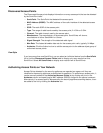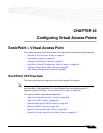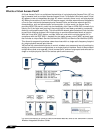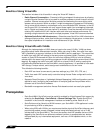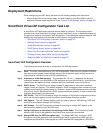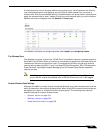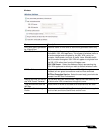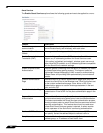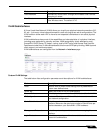
SonicPoint > Virtual Access Point
550
SonicOS 5.8.1 Administrator Guide
Benefits of Using Virtual APs
This section includes a list of benefits in using the Virtual AP feature:
• Radio Channel Conservation—Prevents building overlapped infrastructures by allowing
a single Physical Access Point to be used for multiple purposes to avoid channel collision
problem. Channel conservation. Multiple providers are becoming the norm within public
spaces such as airports. Within an airport, it might be necessary to support an FAA network,
one or more airline networks, and perhaps one or more Wireless ISPs. However, in the US
and Europe, 802.11b networks can only support three usable (non-overlapping) channels,
and in France and Japan only one channel is available. Once the channels are utilized by
existing APs, additional APs will interfere with each other and reduce performance. By
allowing a single network to be used for multiple purposes, Virtual APs conserve channels.
• Optimize SonicPoint LAN Infrastructure—Share the same SonicPoint LAN infrastructure
among multiple providers, rather than building an overlapping infrastructure, to lower down
the capital expenditure for installation and maintenance of your WLANs.
Benefits of Using Virtual APs with VLANs
Although the implementation of VAPs does not require the use of VLANs, VLAN use does
provide practical traffic differentiation benefits. When not using VLANs, the traffic from each
VAP is handled by a common interface on the SonicWALL security appliance. This means that
all traffic from each VAP will belong to the same zone and same subnet (Footnote: a future
version of SonicOS Enhanced will allow for traffic from different VAPs to exist on different
subnets within the same zone, providing a measure of traffic differentiation even without VLAN
tagging). By tagging the traffic from each VAP with a unique VLAN ID, and by creating the
corresponding subinterfaces on the SonicWALL security appliance, it is possible to have each
VAP occupy a unique subnet, and to assign each subinterface to its own zone.
This affords the following benefits:
• Each VAP can have its own security services settings (e.g. GAV, IPS, CFS, etc.).
• Traffic from each VAP can be easily controlled using Access Rules configured from the
zone level.
• Separate Guest Services or Lightweight Hotspot Messaging (LHM) configurations can be
applied to each, facilitating the presentation of multiple guest service providers with a
common set of SonicPoint hardware.
• Bandwidth management and other Access Rule-based controls can easily be applied.
Prerequisites
• Each SonicWALL SonicPoint must be explicitly enabled for Virtual Access Point support by
selecting the SonicPoint > SonicPoints > General Settings Tab: “Enable SonicPoint”
checkbox in the SonicOS management interface and enabling either Radio A or G.
• SonicPoints must be linked to a WLAN zone on your SonicWALL UTM appliance in order
for provisioning of APs to take place.
• When using VAPs with VLANs, you must ensure that the physical SonicPoint discovery and
provisioning packets remain untagged (unless being terminated natively into a VLAN
subinterface on the SonicWALL). You must also ensure that VAP packets that are VLAN
tagged by the SonicPoint are delivered unaltered (neither un-encapsulated nor double-
encapsulated) by any intermediate equipment, such as a VLAN capable switch, on the
network.






